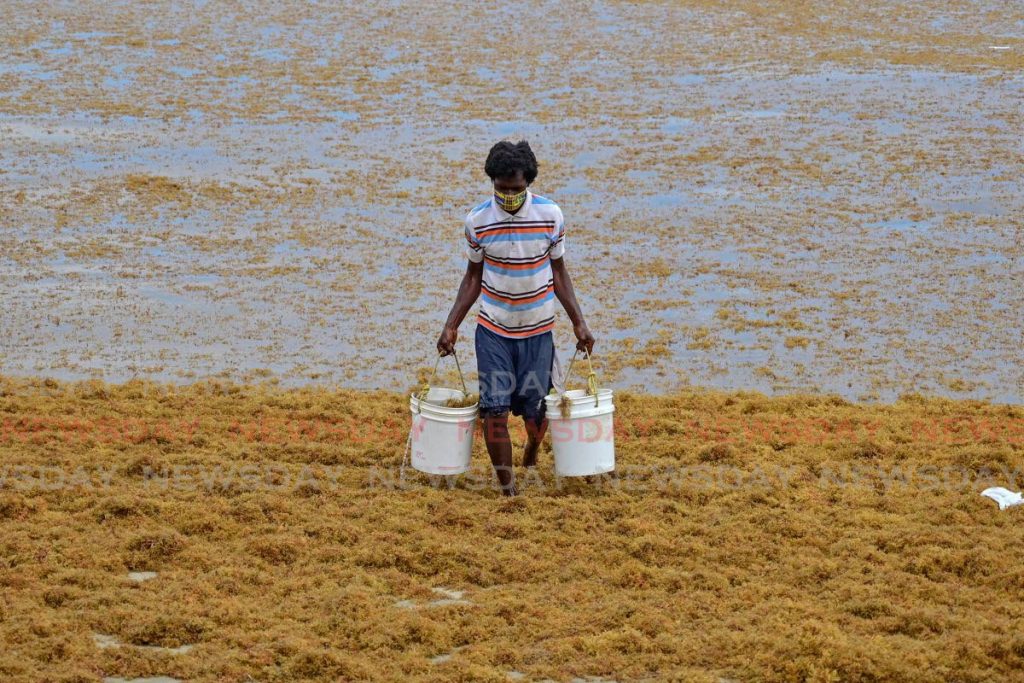Des Vignes eyes US$60k sargassum warning system

Secretary of Infrastructure, Quarries and the Environment (DIQE) Kwesi Des Vignes said his division is looking to improve its early detection of sargassum heading to Tobago.
Des Vignes said Tobago is far ahead of many of countries in the region and the Americas in terms of dealing with the sargassum problem.
On April 30, the Tobago Emergency Management Agency (TEMA) reported sightings of a large mass of sargassum on the Atlantic side of the island.
Providing an update, Des Vignes said clean-up operations at Delaford Bay ended last weekend after an excavator was used to remove the sargassum from the shorelines.
He said the sargassum phenomenon was no new issue, adding that a sargassum management unit has been established, which includes THA divisions, Cepep, URP, TEMA and a number of other non-governmental organisations.
“In general, mechanical interventions tend to be the very last method that we go to remove any sargassum from our beaches.
“We do have a sargassum response plan that we updated recently and as a matter of fact, the division was invited to a regional symposium on sargassum and it was recognised that Tobago is quite far ahead of many of our neighbouring countries and other countries in the region (and) the Americas in terms of dealing with sargassum. So I can say quite confidently that we are doing what we can do,” he said.
Des Vignes explained how Tobago is ahead.
"The fact that we even have a comprehensive sargassum response plan actually puts us quite ahead of many other territories. As a matter of fact, it was shown that in some larger countries what they do is just call out the military to just clear up sargassum on some of the beaches. ...The fact that we have a phased plan, a response plan that deals with three different tiers, it means that we're already ahead and people are following our model."
He said the division is looking at ramping up its early warnings.
“Currently, we use the sargassum sub-regional outlook bulletin, but we are moving to acquire from the University of Florida an early warning system that would improve our capacity to detect or early detection for localised cases of sargassum.”
He said the system costs US$60,000, with an annual maintenance cost of US$40,000.
Des Vignes said it was known that fishermen and communities are affected by sargassum, as he encouraged people to work with the team.
He said the division has not stopped at removing the sargassum but is also using the sargassum as a resource.
He said some people have taken up farming now that the stay-at-home order is in place and they are using the sargassum as a fertiliser.
"And we have been engaging international partners including Algas Organics from St Lucia and others as we look towards other avenues of utilising the sargassum. We have also engaged other agencies in Trinidad; GNF Solutions Ltd, for example and others to provide other types of service.
“We are looking at composting sites about Tobago where we could also minimise the odour, because, of course, we know that there is a lot of hydrogen sulphide and ammonia emissions from the sargassum and we want to minimise those as far as possible.”
He said the sargassum is there for anyone to collect but the public is urged to be cautious when doing so.
Des Vignes said that there is evidence that sargassum can retain heavy metals, such as mercury, and those collecting it should be aware of this.
“We are trying to engage the requisite science through testing to ensure that the sargassum that comes up in Tobago is not so inundated with these heavy metals. But again, please be on the lookout and we are working assiduously to ensure that we are doing all that we can to alleviate the challenges that Tobagonians feel."


Comments
"Des Vignes eyes US$60k sargassum warning system"